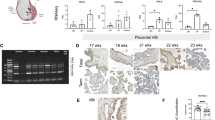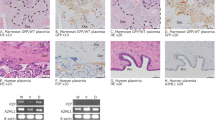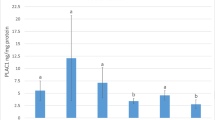Summary
PP14 protein (placental protein 14) is abundantly secreted by the human endometrium under the influence of progesterone. Human PP14 is homologous to β-lactoglobulin, the main component of equine, bovine, and ovine milk whey. A genomic PP14 probe (PP14G1) was used for the chromosome assignment of the PP14 gene. Somatic hybrid cells enabled PP14G1 to be assigned to chromosome 9. In situ hybridization further refined this assignment to 9q34. The localization of the PP14 gene in the region of the ABO locus is consistent with the linkage described in bovines between beta-lactoglobulin and the J blood group (homologous to the human ABO group).
Similar content being viewed by others
References
Bell SC, Bohn M (1986) Immunochemical and biochemical relationship between human pregnancy-associated secreted endometrial alpha1 and alpha2 globulins (alpha1 and alpha2 PEG) and the soluble placental protein 12 and 14. Endocrinology 118:1782–1786
Bell SC, Hales MW, Patel S, Kirman PH, Driffe JO (1985) Proteins synthesis and secretion by the human endometrium and decidua during during early pregnancy. Br J Obstet Gynaecol 92:793–803
Bolton AE, Clough KJ, Stoker KJ, Pockley AJ, Mowles EA, Chapman MG (1987) Identification of placental protein 14 as an immunosuppressive factor in human reproduction. Lancet I:593–595
Dutrillaux B, Lejeune J (1971) Sur une nouvelle technique d'analyse du carytype humain. CR Acad Sci III 272:2638–2640
Hines HC, Kiddy CA, Brum EW, Arawe CW (1969) Linkage among cattle blood and milk polymorphisms. Genetics 62:401–412
Huhtala ML, Seppala M, Narvanen A, Palomaki P, Julkunen M, Bohn H (1987) Amino acid sequence homology between human placental protein 14 and β-lactoglobulins from various species. Endocrinology 120:2620–2622
Human Gene Mapping 10 (1989) 10th International Workshop on Human Gene Mapping. Cytogenet Cell Genet 51:1–1147
ISCN (1981) An international system for human cytogenetic nomenclature — high-resolution banding. Report of the standing committee on human cytogenetic nomenclature. Cytogenet Cell Genet 31:1–32
Joshi SG (1983) A progestagen-associated protein of the human endometrium: basic studies and potential clinical applications. J Steroid Biochem 19:751–757
Julkunen M, Raikar RS, Joshi SG, Bohn H, Seppala M (1986a) Placental protein PP14 and progestagen-dependent endometrial protein are immunologically indistinguishable. Hum Reprod 1:7–8
Julkunen M, Korstinen R, Sjoberg J, Rutanen EM, Wahlstrom T, Seppala M (1986b) Secretory endometrium synthesizes placental protein PP14. Endocrinology 118:1782–1786
Julkunen M, Apter D, Seppala M, Stenman UH, Bohn H (1986c) Serum levels of placental protein 14 reflect ovulation in non conceptional menstrual cycles. Fertil Steril 45:47–50
Julkunen M, Seppala M, Janne OA (1988) Complete amino acid sequence of human placental protein PP 14: a progesterone regulated uterine protein homologous to β-lactoglobulins. Proc Natl Acad Sci USA 85:8845–8849
Larson B (1971) Blood groups and polymorphic proteins in cattle and swine. Ann Génét Sél Anin 3:59–70
Mattei MG, Philip N, Passage E, Moisan JL, Mattei JF (1985) DNA probe localization at 18p13 and band by in situ hybridization and identification of a small supernumerary chromosome. Hum Genet 69:268–271
Meera Kahn P (1971) Enyzme electrophoresis on cellulose acetate gel: zymogram pattern in man-mouse and man-Chinese hamster somatic cell hybrids. Arch Biochem Biophys 145:470–483
Neiman-Sorenson A, Rendel J, Stone WH (1954) The J substance of cattle. II. A comparison of normal antibodies and antigens in sheep, cattle and man. J Immunol 73:407–414
Nguyen VC, Weil D, Finaz C, Cohen-Haguenauer O, Gross MS, Jégou-Foubert C, Tand MF de, Cochet C, Grouchy J de, Frézal J (1986) Panel of twenty-five independent man-rodent hybrids for human genetic marker mapping. Ann Genet (Paris) 29:20–26
Sutcliff RG, Joshi SG, Paterson WF, Bank JF (1982) Serological identity between human uterine protein and human progestagen-dependent endometrial protein. J Reprod Fertil 65:207–209
Vaisse C, Atger B, Potier B, Milgrom E (1990) Human placental protein 14 gene: sequence and characterization of a short dupliation. DNA Cell Biol 9:401–413
Zabel BU, Naylor SL, Sakaguchi AY, Bell GI, Shows TB (1983) High-resolution chromosomal localization of human genes for amylase, propeomelanocortin, somatostatin and a DNA fragment (D 3S1) by in situ hybridzation. Proc Natl Acad Sci USA 80:6932–6936
Author information
Authors and Affiliations
Additional information
Offprint requests to: V.C. Nguyen
Rights and permissions
About this article
Cite this article
Van Cong, N., Vaisse, C., Gross, MS. et al. The human placental protein 14 (PP14) gene is localized on chromosome 9q34. Hum Genet 86, 515–518 (1991). https://doi.org/10.1007/BF00194645
Received:
Issue Date:
DOI: https://doi.org/10.1007/BF00194645




